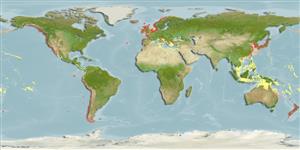Common names from other countries
Environment: milieu / climate zone / depth range / distribution range
Ecologia
. Subtropical
Western Pacific.
Length at first maturity / Tamanho / Peso / Idade
Maturity: Lm ? range ? - ? cm Max length : 3.0 cm H macho/indeterminado; (Ref. )
Relatively small with tentacular crown up to 3.5 centimeters in diameter and 3 cm in height. Smooth green-gray or brown cylindrical column that may or may not have vertical orange or white stripes. 50 to 100 slender, tapering tentacles that are fully retractile, usually transparent, sometimes gray or light green flecked with white.
Known from infralittoral zones (Ref. 85338). Solitary (Ref. 2377). Found on rock surfaces, attached to one spot but can glide over the substrate. Will feed on any animal it can catch and swallow (Ref. 125338).
Life cycle and mating behavior
Maturidade | Reprodução | Desova | Ovos | Fecundidade | Larvas
Capable of both asexual reproduction, through longitudinal fission, and sexual reproduction through release of gametes by both sexes followed by external fertilization and embryonic development (Ref. 3248).
Cairns, S.D., D.R. Calder, A. Brinckmann-Voss, C.B. Castro, D.G. Fautin, P.R. Pugh, C.E. Mills, W.C. Jaap, M.N. Arai, S.H.D. Haddock and D.M. Opresko. 2003. (Ref. 1663)
Status na Lista Vermelha da IUCN (Ref. 130435)
Status no CITES (Ref. 108899)
Not Evaluated
Not Evaluated
Perigo para os humanos
Harmless
Uso pelos humanos
| FishSource |
Ferramentas
Mais informação
Idade/TamanhoCrescimentoComprimento-pesoComprimento-comprimentoMorfologiaLarvasAbundância
Fontes da internet
Estimates based on models
Preferred temperature
(Ref.
115969): 8 - 21.9, mean 12.1 (based on 886 cells).
Vulnerabilidade
Low vulnerability (10 of 100).
Categoria de preço
Unknown.
